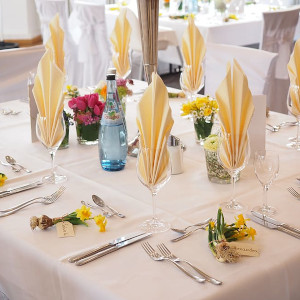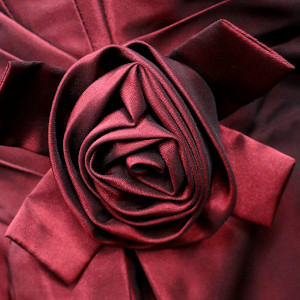The living and dining space is a common area when all the members of the family like to spend some quality time with each other. In this busy life schedule, people hardly find some family time. The dining area is one such corner of the house, which is the most attractive space.
As per the total size of the apartment, the living and dining space depends. Some prefer a lavish table and some prefer a simple but elegant one. The tablecloth and other linens used in a dining table also intensify the whole look.
History of Table Cloth Usage
 Tablecloths have been in use since the medieval period and were most common in the western countries. But as time progressed, the use of table cloths have increased among all the sectors of society. The use of table coverings has become a frequent practice in recent times and they are very common during formal events like weddings. Some people also include tablemats, table runner, napkins, and coasters along with the cover. Most of the time all these items are made in a similar style.
Tablecloths have been in use since the medieval period and were most common in the western countries. But as time progressed, the use of table cloths have increased among all the sectors of society. The use of table coverings has become a frequent practice in recent times and they are very common during formal events like weddings. Some people also include tablemats, table runner, napkins, and coasters along with the cover. Most of the time all these items are made in a similar style.
Varieties of tablecloths are available with different materials. The interior decoration of the whole apartment lightens up when there is an attractive tabletop. It also marks the well being and gives a positive vibe to the entire surroundings.
Varieties of Tablecloths
Table covers are not necessarily meant just for dining tables. It can also be used for side tables beside the bed and center table in the living room. Before the tablewares are placed on the top, the tablecloth is stretched and spread.
Their size and shape directly depend on the size and shape of the table. They can be customized according to an individual’s needs and requirements. The common ones are generally round, oval, and rectangular.
The size of tablecloths is used according to the occasion.
- Formal: For formal events, tablecloths are in the form of a long drop. They are generally longer on all sides.
- Informal: Shorter height of table cloths are used when it comes to friendly, casual, or family dining. The hanging part is shorter than 15 inches.
- Special events: For any special occasion such as weddings or other parties, the covers that are used are mostly floor-length. The stands of the table are hardly visible.
Varieties of Table Cover Materials
Some consumers prefer to purchase tablecloths from the market directly. But the majority of people are more interested in sewing their table cloths. These can be custom made, according to needs.
 A lot of designs can be incorporated, and this gives a unique style and differentiates from the regularly available ones. Tablecloths can be of various types. They are:
A lot of designs can be incorporated, and this gives a unique style and differentiates from the regularly available ones. Tablecloths can be of various types. They are:
- Cotton- They are commonly used in households and are easy to wash and dry.
- Plastic- These are dyed and come in various prints and colors. PVC materials are affordable. They are water-resistant and do not wear off quickly. And can be easily wiped when soiled.
- Nylon- They are used for mass usages like weddings and parties. Soiled ones can be easily washed.
- Satin- These are options for people who want elegance in the look. Satin and silk are used on unique and rare occasions, and they have to be handled with care and washed cautiously because of the delicate material.
Benefits of Using a Table Cloth
Lots of benefits can be listed for the usage of a table cloth.
- Provides padding for the table
- Reduces the damage of the table directly
- Prevents from getting soiled with food or other eatables
- The sharp corners of the tables are covered
- Easy to clean and wipe
- Adds a decorative touch
How to Make a Tablecloth with a Sewing Machine
The basic procedure of how to make a tablecloth is mentioned here. Some supplies are needed as well, so keep them in reach while you start sewing.
 Things that you will need:
Things that you will need:
- Sewing machine
- Needle
- Thread
- Scissors
- Fabric and lining(if required)
- Scale
- Marker or chalk
- Pins
- Measuring tape
Step 1: The most crucial step is first to measure the size of the table for which you are sewing the cover.
Step 2: Cut the fabric of the cover with more than 15 inches from all sides. These extra inches are for the side drop. Also, add ½ inches extra for sewing the edges. Mark it properly with chalk or pencil, so the cut is straight.
Step 3: If you prefer to add a lining, repeat the same process for its cutting as that of the fabric. If there is no requirement of padding, you may skip this step.
Step 4: Pinup and secure both the fabric and the lining together so that they do not get separated from each other while sewing.
Step 5: Use the same color of thread as that of fabric. You may use a different color if you want to add a contrasting feature on the tablecloth.
Step 6: Place the fabric on the sewing machine in the correct place as that of the needle.
Step 7: See that all the settings and adjustment of the machine is as per the fabric.
Step 8: Release the pressure of the paddle and continue to sew all along the edges. Keep on removing the pins while moving forward.
Step 9: Once the sewing is complete on all sides, release it from the machine and turn it upside down. Check if all the edges have been appropriately sewn.
Step 10: Iron the cloth and remove the wrinkles that occurred during sewing.
How to Make a Tablecloth: Final Thoughts
Sewing a tablecloth is quite easy, as seen in the above steps. One can also embroider on the cotton cover to add to the beauty. Simple and plain tablecloths can be customized by adding frills of satins and bows around the edges to give a tint of grandeur.
Modifications in the tablecloths can be done as per the taste of the user. The stitches of the fabric should be done with utmost care so that the threads do not come off with prolong usage. Skilled and experienced people in sewing tablecloths can also look forward to it as a business.
The demand for table cloths in the local market is enormous and can strengthen your productivity. In general, sew your tablecloths and boost up the look of your dull dining area.



